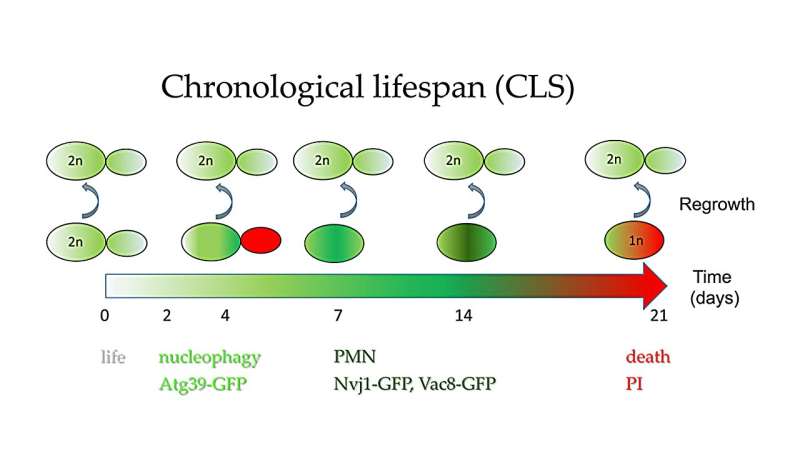This article has been reviewed according to Science X's editorial process and policies. Editors have highlighted the following attributes while ensuring the content's credibility:
fact-checked
proofread
Autophagy's role in DNA loss and survival of diploid yeast cells during chronological aging

A new research paper titled "Live while the DNA lasts. The role of autophagy in DNA loss and survival of diploid yeast cells during chronological aging" has been published in Aging.
Aging is inevitable and affects all cell types. Thus, yeast cells are often used as a model in aging studies. There are two approaches to studying aging in yeast: replicative aging, which describes the proliferative potential of cells, and chronological aging, which is used for studying post-mitotic cells.
In this new study, while analyzing the chronological lifespan (CLS) of diploid Saccharomyces cerevisiae cells, researchers Tuguldur Enkhbaatar, Marek Skoneczny, Karolina Stępień, Mateusz Mołoń, and Adrianna Skoneczna from the Polish Academy of Sciences and Rzeszów University discovered a remarkable phenomenon: ploidy reduction during aging progression.
"To uncover the mechanism behind this unusual process we used yeast strains undergoing a CLS assay, looking for various aging parameters," the researchers explain.
Cell mortality, regrowth ability, autophagy induction and cellular DNA content measurements indicated that during the CLS assay, dying cells lost their DNA, and only diploids survived. The researchers demonstrated that autophagy was responsible for the gradual loss of DNA. The nucleophagy marker activation at the start of the CLS experiment correlated with the significant drop in cell viability. The activation of piecemeal microautophagy of nucleus (PMN) markers appeared to accompany the chronological aging process until the end.
"Our findings emphasize the significance of maintaining at least one intact copy of the genome for the survival of post-mitotic diploid cells," write the researchers.
During chronological aging, cellular components, including DNA, are exposed to increasing stress, leading to DNA damage and fragmentation in aging cells. The researchers propose that PMN-dependent clearance of damaged DNA from the nucleus helps prevent genome rearrangements. However, as long as one copy of the genome can be rebuilt, cells can still survive.
"The observations we made in aging research using yeast as the eukaryotic cell model may help to understand the mechanisms that prevent aneuploidy during aging or cancerogenesis in cells where chromothripsis has occurred," the researchers conclude.
More information: Tuguldur Enkhbaatar et al, Live while the DNA lasts. The role of autophagy in DNA loss and survival of diploid yeast cells during chronological aging, Aging (2023). DOI: 10.18632/aging.205102
Provided by Impact Journals LLC





















